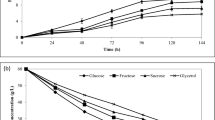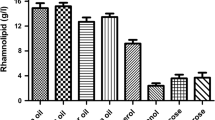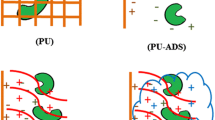Abstract
In this study, polyurethane foam (PUF) was chemically treated to immobilize Streptomyces thermotolerans 11432 for semi-continuous production of acetylisovaleryltylosin (AIV). Based on experimental results, positive cross-linked PUF (PCPUF) was selected as the most effective carrier according to immobilized cell mass. The effect of adsorption time on immobilized mass was investigated. AIV concentration (33.54 mg/l) in batch fermentations with immobilized cells was higher than with free cells (20.34 mg/l). In repeated batch fermentations with immobilized S. thermotolerans 11432 using PCPUF cubes, high AIV concentrations and conversion rates were attained, ranging from 25.56 to 34.37 mg/l and 79.93 to 86.31 %, respectively. Significantly, this method provides a feasible strategy for efficient AIV production and offers the potential for large-scale production.





Similar content being viewed by others
References
Arisawa A, Kawamura N, Narita T, Kojima I, Okamura K, Tsunekawa H et al (1996) Direct fermentative production of acyltylosins by genetically-engineered strains of Streptomyces fradiae. J Antibiot 49:349–354
Alons Morales N, López Gallego F, Betancor L, Hidalgo A, Mateo C, Fernandez-Lafuente R (2004) Reversible immobilization of glutaryl acylase on sepabeads coated with polyethyleneimine. Biotechnol Prog 20:533–536. doi:10.1021/bp0342248
Beg QK, Bhushan B, Kapoor M, Andondal GS (2000) Production and characterization of thermostable xylanase and pectinase from Streptomyces sp. QG-11-3. J Ind Microbiol Biotechnol 24:396–402. doi:10.1038/sj.jim.7000010
Budriene S, Romaskevic T, Pielichowski K (2007) Synthesis and characterization of polyurethane microspheres and their application for immobilization of maltogenase. Polym Adv Technol 18:67–71. doi:10.1002/pat.797
Challis GL, Hopwood DA (2003) Synergy and contingency as driving forces for the evolution of multiple secondary metabolite production by Streptomyces species. Proc Natl Acad Sci 100(suppl2):14555–14561. doi:10.1073/pnas.1934677100
Cui C, Tao Y, Li L, Chen B, Tan T (2013) Improving the activity and stability of Yarrowia lipolytica lipase Lip2 by immobilization on polyethyleneimine-coated polyurethane foam. J Mol Catal B Enzym 91:59–66. doi:10.1016/j.molcatb.2013.03.001
Devi S, Sridhar P (1999) Optimization of critical parameters for immobilization of Streptomyces clavuligerus on alginate gel matrix for cephamycin C production. World J Microbiol Biotechnol 15:185–192. doi:10.1023/A:1008814427427
Devi S, Sridhar P (2000) Production of cephamycin C in repeated batch operations from immobilized Streptomyces clavuligerus. Process Biochem 36:225–231. doi:10.1016/S0032-9592(00)00194-1
Du L, Liu RH, Ying L, Zhao GR (2012) An efficient intergeneric conjugation of DNA from Escherichia coli to mycelia of the lincomycin-producer Streptomyces lincolnensis. Int J Mol Sci 13(4):4797–4806. doi:10.3390/ijms13044797
Elibol M (2002) Product shifting by controlling medium pH in immobilized Streptomyces coelicolor A3(2) culture. Process Biochem 37:1381–1386. doi:10.1016/S0032-9592(02)00019-5
Huang G, Okamoto R, Hikita A (1997) Optimization of conditions for conversion of tylosin to a novel antibiotic, acetyl-isovaleryl tylosin (AIV), Streptomyces thermotolerans and scale-up to 200-liter pilot-scale fermentor. J Ferment Bioeng 84:77–81. doi:10.1016/S0922-338X(97)82790-0
Huang GW, Okabe M, Kahar P, Tsunekawa H, Park Y (2001) Optimization of tylosin feeding rate profile in production of Acetyl-Isovaleryl Tylosin (AIV) from tylosin by Streptomyces thermotolerans YN554. J Biosci Bio-Eng 5:504–508. doi:10.1263/jbb.91.504
Ishida BK (1988) Improved diosgenin production in Dioscorea deltoidea cell cultures by immobilization in polyurethane foam. Plant Cell Rep 7:270–273. doi:10.1007/BF00272540
Khang YH, Shankar H, Senatore F (1988) Modeling the effect of oxygen mass transfer on β-lactam antibiotic production by immobilized Cephalosporium acremonium. Biotechnol Lett 10:861–866
Kurosawa H, Matsumura M, Tanaka H (1989) Oxygen diffusivity in gel beads containing viable cells. Biotechnol Bioeng 34:926–932. doi:10.1002/bit.260340707
Kim IC, Kim CH, Hong SI, Hong SW (2001) Fed-batch cultivation for the production of clavulanic acid by an immobilized Streptomyces clavuligerus mutant. World J Microbiol Biotechnol 17:869–872. doi:10.1023/A:1013895617923
Kim CJ, Chang YK, Chun GT, Jeong YH, Lee SJ (2001) Continuous culture of immobilized Streptomyces cells for kasugamycin production. Biotechnol Prog 17:453–461. doi:10.1021/bp010020k
López-Gallego F, Betancor L, Hidalgo A, Hidalgo A, Alonso N, Fernández-Lafuente R, Guisán JM (2005) Co-aggregation of enzymes and polyethyleneimine: a simple method to prepare stable and immobilized derivatives of glutaryl acylase. Biomacromolecules 6:1839–1842. doi:10.1021/bm050088e
Liu S, Lin B, Yang X, Zhang Q (2007) Carbon-nanotube-enhanced direct electron-transfer reactivity of hemoglobin immobilized on polyurethane elastomer film. J Phys Chem B 111:1182–1188. doi:10.1021/jp065344b
Okamoto R, Nomura H, Tsuchiya M, Tsunekawa H, Fuknmoto T, Inui T, Takeucki T, Umezawa H (1979) The activity of 4″-acylated tylosin derivatives against macrolide-resistant Gram-positive bacteria. The Journal of antibiotics 32:542–546
Okamoto R, Fukumoto T, Nomura H, Kiyoshims K, Takamatsu A, Takeuchi T (1980) Physico-chemical properties of new acyl derivatives of tylosin produced by microbial transformation. J Antibiot 33:1300–1308
Okamoto R, Tsuchiya M, Nomura H, Iguchi H, Kiyoshima K, Hori S, Inui T, Sawa T, Takeuchi T, Umezawa H (1980) Biological properties of new acyl derivatives of tylosin. J Antibiot 33:1309–1315
Ozdemir E (2009) Biomimetic CO2 sequestration: 1. Immobilization of carbonic anhydrase within polyurethane foam. Energy Fuels 23:5725–5730. doi:10.1021/ef9005725
Papagianni M, Joshi N, Moo-Young M (2002) Comparative studies on extracellular protease secretion and glucoamylase production by free and immobilized Aspergillus nigercultures. J Ind Microbiol Biotechnol 29:259–263. doi:10.1038/sj.jim.7000289
Pires-Cabral P, da Fonseca MMR, Ferreira-Dias S (2009) Synthesis of ethyl butyrate in organic media catalyzed by Candida rugosa lipase immobilized in polyurethane foams: a kinetic study. Biochem Eng J 43:327–332. doi:10.1016/j.bej.2008.11.002
Quek E, Ting YP, Tan HM (2006) Rhodococcus sp. F92 immobilized on polyurethane foam shows ability to degrade various petroleum products. Bioresour Technol 97:32–38. doi:10.1016/j.biortech.2005.02.031
Schügerl K, Bayer T, Niehoff J, Oller M, Zhou W (1988) Influence of cell environment on the morphology of molds and the biosynthesis of antibiotics in bioreactors. In: Proceedings of 2nd conference on bioreactor fluid dynamics. Elsevier, Amsterdam 132: 229–243
Srinivasulu B, Prakasham RS, Jetty A, Srinivas S, Ellaiah P, Ramakrishna SV (2002) Neomycin production with free and immobilized cells of Streptomyces marinensisin an airlift reactor. Process Biochem 38:593–598. doi:10.1016/S0032-9592(02)00182-6
Shu C, Cai J, Huang L, Zhu XC, Xu ZN (2011) Biocatalytic production of ethyl butyrate from butyric acid with immobilized Candida rugosa lipase on cotton cloth. J Mol Catal B Enzym 72:139–144. doi:10.1016/j.molcatb.2011.05.011
Survase SA, van Heiningen A, Granström T (2013) Wood pulp as an immobilization matrix for the continuous production of isopropanol and butanol. J Ind Microbiol Biotechnol 40:209–215. doi:10.1007/s10295-012-1219-5
Tsuchiya M, Suzukake K, Hori M, Sawa T, Taken T, Umezawa H (1981) Studies on the effects of 3-acetyl-4″-isovaleryltylosin against multiple-drug resistant strains of Staphylococcus aureus. J Antibiot 34:305–312
Torres R, Pessela BCC, Mateo C (2004) Reversible immobilization of glucoamylase by ionic adsorption on sepabeads coated with polyethyleneimine. Biotechnol Prog 20:1297–1300. doi:10.1021/bp049943g
Weaire DL, Hutzler S (2001) The physics of foams. Oxford University Press, Oxford
Wei P, Chen J, Lu Y (2010) High density cultivation of Dictyostelium discoideum in a rotating polyurethane foam-bed bioreactor. World J Microbiol Biotechnol 26:1117–1123. doi:10.1007/s11274-009-0278-x
Weihua W (2014) Overexpression of acyB and Immobilization of Streptomyces thermotolerans on Polyurethane foam to improve production of Acetylisovaleryltylosin. MS thesis. Tianjin University, 2014
Yamaguchi T, Ishida M, Suzuki T (1999) An immobilized cell system in polyurethane foam for the lipophilic micro-alga Prototheca zopfii. Process Biochem 34:167–172. doi:10.1016/S0032-9592(98)00084-3
Zarzyka I (2014) The modification of polyurethane foams using new boroorganic bolyols. II. Polyurethane foams from boron-modified hydroxypropyl urea derivatives. Polym-Plast Technol Eng 53(2):207–215. doi:10.1080/03602559.2013.844236
Acknowledgments
We are grateful for the financial support from the National Natural Science Foundation of China (Grant No. 31370091) and Natural Science Foundation of Tianjin (Grant No. 10JCYBJC10300).
Author information
Authors and Affiliations
Corresponding author
Electronic supplementary material
Below is the link to the electronic supplementary material.
Rights and permissions
About this article
Cite this article
Zhu, H., Wang, W., Liu, J. et al. Immobilization of Streptomyces thermotolerans 11432 on polyurethane foam to improve production of Acetylisovaleryltylosin. J Ind Microbiol Biotechnol 42, 105–111 (2015). https://doi.org/10.1007/s10295-014-1545-x
Received:
Accepted:
Published:
Issue Date:
DOI: https://doi.org/10.1007/s10295-014-1545-x




